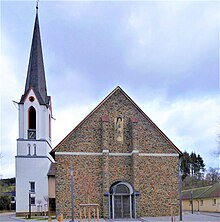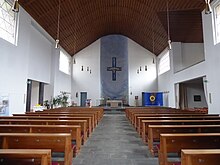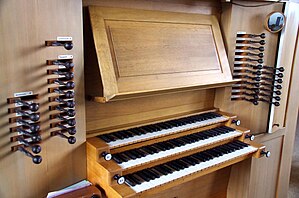St. Anna (Hellenthal)
St. Anna is the Roman Catholic parish church of Hellenthal in the Euskirchen district in North Rhine-Westphalia .
The church is St. Mother Anna consecrated.
location
The church building is located in the center of Hellenthal on the corner of Kölner Strasse ( B 265 ) and Hardtstrasse. The old choir is east, the new choir faces north. The river Olef flows north of the parish church . The Catholic kindergarten is to the east and the parish hall to the north.
General
Hellenthal originally belonged to two parishes , one part belonged to Schleiden and the other part to the Reifferscheid parish . A church in Hellenthal was mentioned as early as 1260, about which nothing more is known. In the Schleiden part, the Steinfeld monastery had a chapel built at the beginning of the 16th century ; at that time the monastery had properties in Hellenthal. In the Schleiden part of Hellenthal, the Reformation was able to prevail in 1561 , which led to the introduction of the Lutheran creed. It was not until 1620 that the Schleiden part was re - Catholicized in the course of the Counter Reformation . In contrast, the Hellenthals district of Reifferscheider remained with the Catholic faith. In 1697 the inhabitants of the Schleiden and Reifferscheider parts of Hellenthals reached jointly that a mass was held in the chapel on Sundays and public holidays. 11 years later, in 1708, Hellenthal received his own vicar in Johann Peter Bock . In 1802, in the course of the French parish registrations, Hellenthal was changed to the parish of Blumenthal , which meant that Hellenthal was no longer divided into two parishes. At that time the place belonged to the diocese of Liège . In 1821 Hellenthal came to the re-established Archdiocese of Cologne as a branch of the Blumenthal parish . On August 29, 1834, Hellenthal was finally separated from the Blumenthal parish and raised to an independent parish by the Archbishop of Cologne, Ferdinand August von Spiegel . The parish has been part of the Aachen diocese since 1930 .
Building history
The first chapel in Hellenthal already existed in the 13th century. A new chapel was built at the beginning of the 16th century. It was a two-bay hall church made of rubble stones with a bell tower , five-sided choir closure and ribbed vaults, which was elevated to a parish church in 1834. Due to the increased population, this church became too small at the end of the 19th century and a new building was decided. In 1903 this church was finally torn down except for the choir . The choir has served as a cemetery chapel since then.
In 1886 the parish bought a piece of land to build a new church. The Bonn architect Gerhard Franz Langenberg made the plans for the new building . He created a neo-Gothic hall church with a bell tower in front in the west and a five-sided choir in the east. The foundation stone was laid on September 25, 1892 and the new parish church was completed by 1894, so that the new parish church was consecrated on October 4, 1894 .
In the course of the Second World War , the new parish church was almost completely destroyed on October 12th and 13th. Only the bell tower and the choir walls remained. 1951 began with the construction of the church, into which the choir and bell tower were integrated. The new components were built from rubble stones typical of the area. The planning of the new church was in the hands of the Rheydter architect Alfons Leitl . The new building was placed as a hall church across the destroyed nave, so that the old church tower and the old choir now serve as a transept . The consecration took place on August 22, 1954 by the Aachen auxiliary bishop Friedrich Hünermann .
Furnishing
There is modern equipment in the church. Worth mentioning are the paintings on the double doors of the organ and on the organ gallery, which the Bonn artist Egbert Verbeek created in the 1980s. The altar cross also comes from him.
The organ is a work of the local company Weimbs Orgelbau from 1986. The slider-drawer instrument has 32 registers on three manual works and a pedal. The tractors are mechanical.
|
|
|
|
|||||||||||||||||||||||||||||||||||||||||||||||||||||||||||||||||||||||||||||||||||||||||||||||||||||||||||||||||||
- Coupling : II / I, III / I, III / II, I / P, II / P, III / P
- Effect register: Cymbelstern
The stained glass windows were made according to designs by the architect Alfons Leitl in 1953.
Bells
In 1894, the Otto bell foundry cast three bronze bells for the Anna Church, one of which was melted down during the First World War. In 1934 Otto delivered a new bell. It was melted down in World War II. Today there are five bronze bells from two different foundries in the bell tower.
|
No. |
Surname |
Caster |
Casting year |
Diameter (mm) |
Mass (kg, approx.) |
Percussive ( HT - 1 / 16 ) |
| 1 | Wolfgang Hausen-Mabilon, Mabilon bell foundry , Saarburg | 1983 | - | - | it 1 | |
| 2 | Karl Otto, F. Otto , Hemelingen | 1894 | - | - | ges 1 | |
| 3 | Wolfgang Hausen-Mabilon, Mabilon bell foundry, Saarburg | 1983 | - | - | as 1 | |
| 4th | Karl Otto, F. Otto, Hemelingen | 1894 | - | - | b 1 | |
| 5 | Wolfgang Hausen-Mabilon, Mabilon bell foundry, Saarburg | 1983 | - | - | of the 2nd |
Pastor
The following pastors have been pastors at St. Anna so far:
| from ... to | Surname |
|---|---|
| 1906-1936 | Heinrich Klösgen |
| 1936-1941 | Leonhard Bauer |
| 1941-1945 | Josef Conrads |
| 1945–1974 | Heinrich Klais |
| 1975-1983 | Bernhard Frohn |
| 1983-1991 | Josef Witt |
| 1991-2009 | Lothar Tillmann |
| Since 2009 | Philipp Cuck |
Individual evidence
- ^ History. In: Internet presence of the parish. Retrieved August 23, 2017 .
- ↑ Handbook of the Diocese of Aachen 3rd edition, published by the Episcopal General Vicariate, Aachen 1994, p. 530.
- ^ Handbook of the Diocese of Aachen 3rd edition, edited by the Episcopal General Vicariate, Aachen 1994, p. 531.
- ↑ Information about the organ (as of May 31, 2018)
- ↑ Our parish church St. Anna in Hellenthal. In: Internet presence of the parish. Retrieved August 23, 2017 .
- ↑ Hellenthal, Catholic Church of St. Anna. In: Forschungsstelle Glasmalerei des 20. Jahrhundert eV Accessed on 23 August 2017 .
- ^ Gerhard Reinhold: Otto bells. Family and company history of the Otto bell foundry dynasty . Self-published, Essen 2019, ISBN 978-3-00-063109-2 , p. 588, in particular pages 435, 507, 538 .
- ↑ Gerhard Reinhold: Church bells - Christian world cultural heritage, illustrated using the example of the bell founder Otto, Hemelingen / Bremen . Nijmegen / NL 2019, p. 556, in particular pp. 411, 473, 497 , urn : nbn: nl: ui: 22-2066 / 204770 (dissertation at Radboud Universiteit Nijmegen).
- ^ Handbook of the Diocese of Aachen 3rd edition, edited by the Episcopal General Vicariate, Aachen 1994, p. 531.
- ^ Handbook of the Diocese of Aachen 3rd edition, edited by the Episcopal General Vicariate, Aachen 1994, p. 531.
- ↑ Catholic Church: At the end of her strength. In: Kölner Stadt-Anzeiger. March 9, 2009. Retrieved August 23, 2017 .
Web links
Coordinates: 50 ° 29 ′ 28.3 " N , 6 ° 26 ′ 17.7" E



